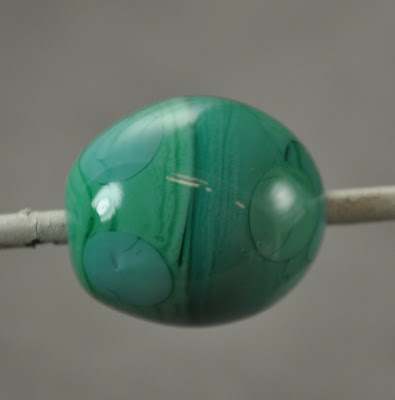
When I saw
Karen Leonardo's tools online - it was lust at first site. Gotta get me those.
But which ones? There were different tools, and different sizes? Which ones would be best? So I solved that problem in my usual manner. I bought all of them.
She has a number of tools, but two main types caught my attention. Both are mashers, but one is shaped - called a petal puller - and the other is intended to leave a pattern - the fishbone mashers. The leave a raised pattern on the glass that is reminiscent of a fishbone - you know, the cartoony spine and ribs - or a leaf vein pattern. She must have then decided it would be good to have the same thing oriented in the other direction, like a feather instead of a fish bone. These are called, logically enough - featherbone.

Shown here are the featherbone mashers. They come in Large, medium, and fine.

I personally like these for making leaves, as it works with the way I make leaves, which is to make a gather, mash, and that rounded bottom end of the gather is now the top of the leaf, and the part that pulls out to a point and is still attached to the rod - that is the point of the leaf. I seem to be doing it the reverse of everyone else - but that would be normal for me.
How to Use 'emKaren Leonardo has videos of how to use them on her website -
www.justleonardo.com. Whatever you do - do NOT go to this website using Firefox. MSIE works - Firefox and Chrome do not. The videos just won't play in Chrome, but in Firefox - they all load automatically and start to play - so there are a half dozen versions all talking to you at once. It is quite frightening. ;-)
They are useful to watch, however.
Karen suggests using a small amount of beeswax as a lubricant on the tools. Small amount that is - and I have no idea about small. Let me just say - I have bee's wax on my graphite marver, the torch marver, the torch, and some of the glass - oh and it burns quite nicely.

To use these - make a gather of glass, and let it stretch a little. In her video's Karen mashes with the tool, and then pulls off the leaf from the rod and drops onto a hot plate.
When I make them, I let the gather droop, flatten it first with flat mashers, pulling it slightly to elongate, then reheat and press with the pattern mashers. At that point - it is still attached by a narrow piece of glass to the rod. I heat the rounded end and a rod of glass and make the loop, and then warm a pair of tweezers to hold them with while I melt through and disconnect from the rod.
I'm sure that there are many different approaches to using these, and they all work better or worse depending on your own personal style. I did find that if I did not pre-flatten - while I got a deeper and more dramatic pattern - I had to let the glass and the tools cool significantly before the would release from each other. And with the fine tool - it just took too long - the glass either would not release or was breaking. With the fine tool - eventually I had to give up straight mashing and pre-mash. I believe I am working larger than she shows in the video however. What a surprise!
You can see how the three sizes look comparatively from the photo.
I think the medium and large sizes are the best for my own working style.
I did notice some quality control issues. Most of them come together flat like this, but

one set had mis-aligned plates like this. I'm not sure that it is a big deal and makes much difference. By the time you have squished the glass - I'm not sure that you will actually notice any irregularity in the pattern. Still - it's not really the sort of thing you want to notice when the tools arrive.

Here's another observation on the way the tools come together - and again, it may be completely irrelevant. The paddles are welded onto tweezers for handles. They are fairly flexible, and, as you've probably observed by now - anything that uses this approach is only ever parallel in one place in the squeezing process. Hence the appeal of the "
Truly Parallel Mashers."


It occurs to me to wonder if, when mashing the glass deeply - as the glass moves up into the gaps that make up the pattern, if there is some bending of the glass (to accommodate the changing arc of the mashers) that is making it hard to get the glass off the mashers after it cools and stiffens.
Or, if the scale of it is all just too small to make any difference.
Maybe I'm over squeezing. Anyhow - I have more success with the medium and larger ones. And I do like them - They make lovely leaves in next to no time.
























